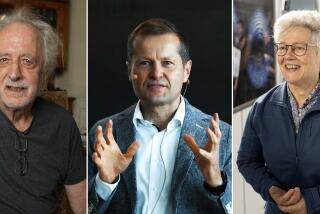DNAâs Double Helix a Theory--Until Now
This January, scientists got their first direct look at a molecule, and a very important molecule at that.
Scientists have been looking at objects that were too small to see with the naked eye for nearly 400 years. The trick at first was to use lenses that forced light to bend and in this way focus and enlarge the image of the object that reflects the light. The device used to do so was the microscope.
As time went on, microscopes were improved until finally they could magnify objects 1,000 times. At that point, scientists ran up against a physical barrier. Light consists of waves. These waves are tiny, but the objects under the microscope were tiny, too. If the objects were tiny enough, they were smaller than the light waves being used to view them. The light waves then tended to skip over them so the objects could not be seen.
To get around this, you might use shorter light waves such as ultraviolet. For a while, therefore, scientists used ultramicroscopes, but these represented only a small improvement. Still shorter waves could not be focused properly.
But then, in 1923, a French scientist, Louis de Broglie, pointed out that subatomic particles ought to exist in wave form, too. In 1925, an American scientist, Clinton J. Davisson, was able to detect such waves produced by electrons. These electron-waves were much shorter than ordinary light-waves. They were, in fact, about the size of X-ray waves. But where X-ray waves would be extremely difficult to focus, electrons and their waves could easily be focused by magnetic fields.
In 1932, the first device used to focus electron-waves and enlarge the images of objects in that way was constructed by a German scientist, Ernst Ruska. This was an âelectron microscope.â It was crude at first, but over the years it was refined and improved, until it could enlarge objects 300,000 times.
At first, in such instruments, electrons had to pass through an object to produce an enlarged image. Scientists had to work with very thin slices of material. But then, ways were found to produce a very thin, sharp beam of electrons and play that beam over the surface of an object. The beam âfeltâ its way, so to speak, across the surface, scanning it and producing an enlarged image. This was a âscanning electron microscope.â
Now, a still newer version produces the electrons by means of what scientists call a tunneling effect and we have a âscanning tunneling electron microscopeâ that has reached new heights of magnification. It can now magnify 1 million times and was used in January to take a first-ever look at a molecule of DNA (deoxyribonucleic acid) by Miguel B. Salmeron and others at the Lawrence Livermore Laboratory in California.
DNA is important because it carries the blueprint of life. Every living cell contains a set of DNA molecules that are constantly replicating themselves, passing the newly created molecules on to daughter cells. Such sets also exist in sperm and egg cells, so that they can be passed on from parents to children. Every living species has its own set and there are also tiny differences in the sets of different individuals of the same species.
The importance of DNA was first recognized in 1944, and scientists labored to find out how these molecules could produce other molecules exactly like themselves.
In 1953, British scientist Francis H.C. Crick and his American co-worker, James D. Watson, worked it out. X-rays, in passing through molecules, tend to bounce to the side. Photographs of such X-rays produce dots where the X-rays bounce, and from such âX-ray diffraction patternsâ it is possible to deduce the shape of the molecule. It took a long time and careful work, but it finally turned out that the DNA molecule consisted of two complex strands of atoms twined in a double helix (the shape of bedsprings). Each strand had a complicated shape, and the two strands fit each other exactly.
When DNA forms another molecule like itself, the two strands unwind and each one picks up small groups of atoms from the cell fluid and puts them together into a new strand that fits exactly upon the original one. Each strand serves as a model to form a new partner for itself. In the end, then, each DNA molecule produces two DNA molecules exactly alike.
This work brought Watson and Crick the Nobel Prize in 1962, and their work was considered a triumph of subtle scientific deduction. They described the double helix of the DNA molecule and its workings in precise detail, even though it was much too small to actually be seen.
But now, 36 years after the work of Watson and Crick, pictures of a DNA molecule have been taken with a scanning tunneling electron microscope--and no subtle reasoning is required. There is the double helix, visible to the eye. The molecule coils as it is supposed to. From the image, it is possible to work out the distance between successive coils. It is about 1/5,500,000th of an inch.
Salmeron and his group are planning to refine the method further to see if they can see even finer details of the strands. They will try to obtain images of other molecules too.






